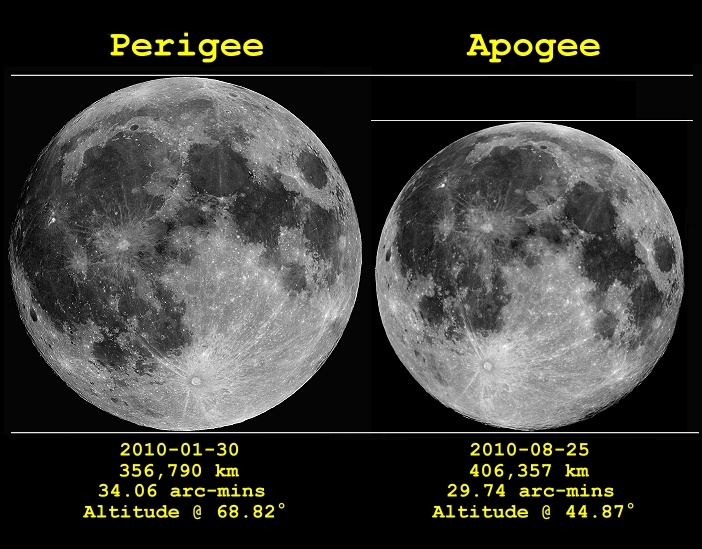
A common misconception is that the moon is larger when it is near the horizon than when it is high overhead. However,
this optical illusion is not true, for the apparent size of the moon is virtually the same when it is rising or setting
near the horizon or when viewed overhead (in fact, it is very slightly smaller when viewed near the horizon due to
refraction as well as the greater added distance in observing across the earth's radius). This illusion has been wrongly
attributed to landmarks near the horizon, such as homes and trees, supposedly giving a sense of perspective and whereas
the same perspective is lost when looking at the overhead moon bathed in an empty sky. As noted by
Donald E. Simanek and
Carl J. Wenning, the real reason behind this
trick by our brain is the perception of the moon being against a "close" or "distant" foreground and which is lucidly
described by the above two references.
In contrast, it is puzzling that when a physical change in the apparent size of the moon does occur, due to its
elliptical orbit around our planet, the change in the apparent diameter which can be up to 14% between apogee and
perigee, is not noticed at all. In fact, the change in the apparent diameter of the moon is a monthly phenomenon and is
something that could be discerned quite easily during any given lunation by looking very carefully at the full moon and
the waning crescent thirteen days later (or observing a waxing crescent thirteen days earlier)!
At apogee, the moon is approximately 406,500 km away from earth with an apparent diameter of about 29.5' whereas, at
perigee, it is approximately 356,500 km away and is characterized with an apparent diameter of about 33.6'. This
difference of 50,000 km between apogee and perigee leads to the dramatic change in the apparent diameter as illustrated
by the two full moons below which were strategically selected during 2010 so as to have the full moon as near to its
minimum possible perigee and maximum possible apogee as possible when crossing the local meridian.
Furthermore, the apogee full moon below, captured during late summer, was slightly muted in colour when crossing the
southern meridian due to its relatively low altitude during each summer and in contrast to the sun when the latter is
at its highest during the same season. These relative positions between the sun and the moon are juxtaposed six months
later and during mid-winter with the (perigee) moon at a much higher altitude relative to six months earlier (note the
absence of muted colouration due to atmospheric effects and sharper image) as well as relative to the sun. The sun is
now also much lower in the sky as compared to six months earlier (see
here).
Note: The change in the apparent diameter of the sun due to perihelion and aphelion is
fully documented elsewhere on this website (see here).
|
Body: Moon Mass: 0.0123 x Earth Mean Eq Diameter: 0.2719 x Earth Distance: 356,790 - 406,357 km Sidereal Rev: 27d 07h 43m 11s Age:
Phase:
Diameter:
Magnitude: -12.7 / -12.7 Rukl: N/A |
 |
Date:
Location: Athens, Greece Equipment: AP 160/f7.5 StarFire EDF AP 1200GTO GEM Canon EOS 350d Baader UV/IR-Cut Exposures:
JPG Fine Image Format 3456x2304 Image Size Manual Mode Software: Digital Photo Pro V2.1.1.4 Photoshop CS2 Processing: Unsharp Masking Resampling (20%) Layers & Masks JPG Compression |